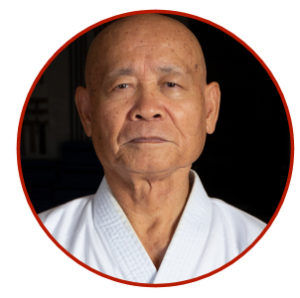A Modern Approach to Traditional Karate

Founder of Kōburyū
President of Okinawa Kōburyū Karateō Kobudō Kōbukai
Okinawa, Japan, is the birthplace of karate and kobudō. Kōburyū is a modern style of traditional Okinawan karate and kobudō (weapons of ancient Okinawa) emphasizing efficient and powerful use of the human body.
How can a karate style be both modern and traditional at the same time? Most karate masters of today are content to simply pass on exactly what was taught to them in exactly the way that it was taught to them. This is not true to the history of the fighting arts of Okinawa.
Historically, the fighting arts of ancient Okinawa were never static. Okinawa was a land of seafarers. Ideas from Japan, Korea and the many fighting arts of Southeast Asia were incorporated into the native Okinawan fighting art called te (ti in the Okinawan dialect). As a protectorate of the powerful Ming Dynasty of China, Okinawan fighting arts were especially influenced by Chinese kung fu. The effectiveness of the Okinawan fighting arts derived from this great melting pot of ideas and methodologies.
Sōke Kaichō Kinjō, founder of Kōburyū, believes that karate should continue to be an evolving art. Like the karate masters of old, he has continued to analyze and incorporate new ways to generate power and effectiveness while remaining true to the roots of karate.
Sōke Kaichō Kinjō spent much of his karate career studying and teaching in the Uechi Ryū family of Okinawan karate. After over 40 years of in-depth analysis, Sōke Kaichō Kaichō’s movement and techniques had taken a different path. That difference became Kōburyū, a practical style of modern karate emphasizing efficient and powerful use of the human body.
From the beginning of his karate career, Sōke Kaichō Kinjō also practiced the Matayoshi style of kobudō, the use of the weapons of ancient Okinawa. He came to believe that karate and kobudō are inseparable, like two halves of the same coin. Therefore he created Kōburyū to include both karate and kobudō under one unified theory of movement.
Shihan David Lamb

Shihan Dave Lamb first began his martial arts training in high school by studying judo. After college, he started Tae Kwon Do in 1975, receiving his black belt in 1980. Upon seeing the effectiveness of Pang Gai Noon Ryu, a Chinese/Okinawa style, he switched to this for over 10 years! In 1990, he contacted Sensei George Mattson of the North American Chapter of Uech I Ryu, joining that organization until now. He is currently a member of the Okinawa Koburyu Karatedo Kobudo Kobukai, holding the rank of Yandan, and the title of shihan. He enjoys learning and teaching karate through hard work and having fun while practicing! Classes are small and lots of individual attention is given to each student!
Shihan Dave graduated from Texas Tech University (Psychology and Sociology), moving to Nebraska as a VISTA volunteer. He worked a variety of jobs after that, and was offered a job teaching at Southeast Community College in the Human Services Program, where he taught for 38 years. Dave and his wife of 48 years have 4 daughters, and 7 grandchildren.
Dave began teaching karate at SCC in 1990, moved his class to Capital City Gymnastics in 1998, and currently is teaching at Connection Point.